
Scope
This lab covers issues dealing with polygonizing a non-topological vector data set, creating polygon statistics and analyzing results within MIGS and MapInfo software packages.
Software
| Vector Manipulation | MIGS |
| Desktop Mapping | MapInfo |
| Operating System | Windows NT |
Data Inputs
| Region of Interest | Greenland |
| Projection | unknown |
| Vector Data | greenlnd.bsf |
Method
The flowchart illustrates the process involved of this lab, in Gane-Sarson notation.
In comparing the two reduced/smoothed maps, it appears that the gl4 data (derived from coordinate averaging, then Peucker method), better represents the original map. The screenshot below (figure 2) illustrates that the gl4 data better handles the point reduction for the greenlnd dataset, as more detailed is shown and retained in comparison to the gl2 data (Peucker method, then coordinate averaging).
The order of operations (reduce/smooth vs. smooth/reduce) produces better results when performing smooth/reduce operations. It appears that smoothing operations are better suited to take place prior to point reduction operations.
The order of these operations is not reversible, knowing the mechanics of coordinate smoothing and the Douglas-Peucker algorithm. The Douglas-Peucker algorithm, as a point reduction method, lowers the amount of output data, producing generalized results. Smoothing derived results can result in output data less representative of its original data. As such, these processes cannot be reversible, and the outputs of them cannot be reversible to generate the original input data. The gl4 dataset also boasts less output coordinates, less coordinates per line segment, shorter line lengths per segment (see MIGS FILESTAT report tables at conclusion).
The order of these operations is almost like trying to resample raster data for more granularity, in comparison to resampling raster data for less granularity. More accurate, representative results are generally produced when the data inputs are richer. In this context, and in the context of this experiment, it makes sense to smooth data, then reduce the derived data.
The MapInfo smoothed map appears to output a well-represented map of the input, especially given the ease of use within the software. However, the smooth operation cannot be controlled (via parameters) to control the smoothing, which can be a caveat if the user desires more control when executing processes and algorithms in MapInfo. A user cannot control smoothing (or unsmoothing) in MapInfo v3.0.5 or v4.1.2.

This experiment provides some insights into visually interrogating data generalization procedures. It is also possible, and more accurate, to evaluate results by measures of rates of difference between input and output data, as well as analyzing directional trends (curvilinearity).